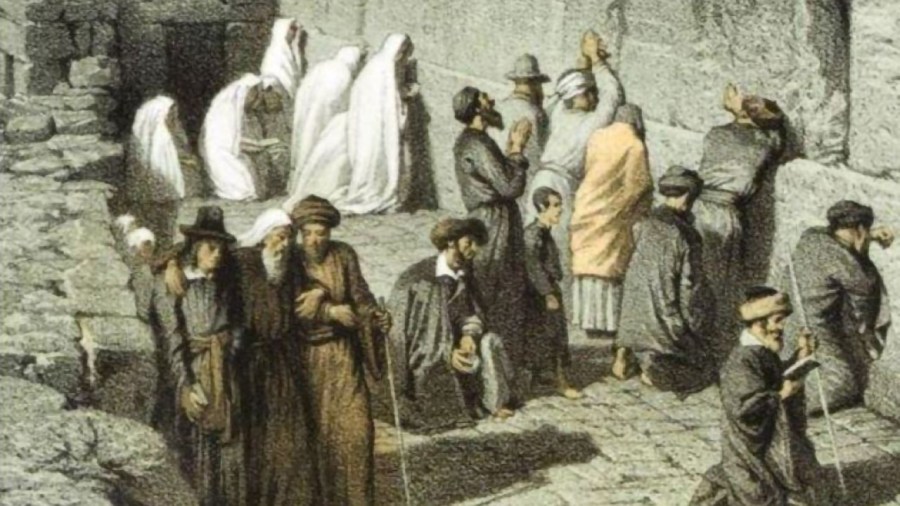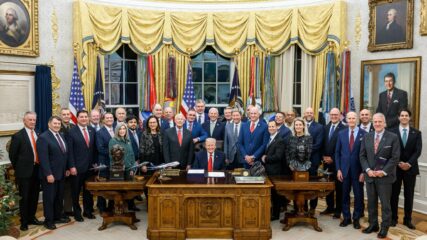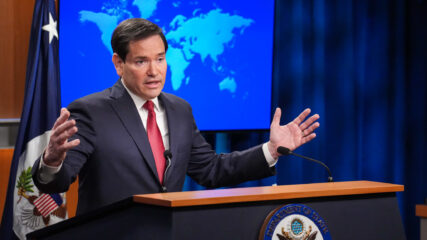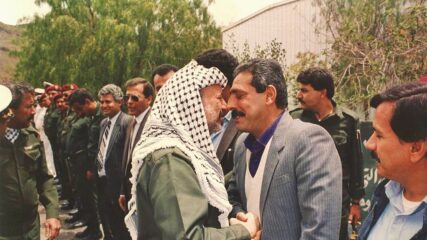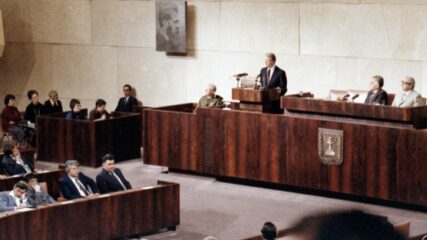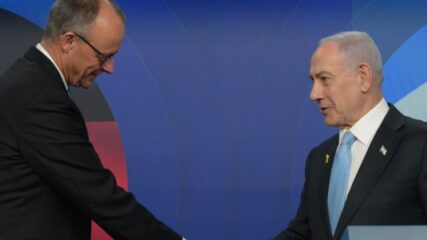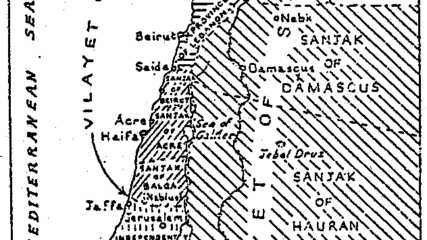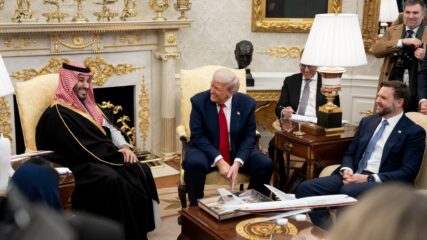Nadav Shragai, Jerusalem Center for Public Affairs, July 29, 2020
With permission, read full article at JCPA.
Institute for Contemporary Affairs
Founded jointly with the Wechsler Family Foundation
Vol. 20, No. 16
Against the background of the Jordanian condemnation of Israel for work carried out by Israel on the southern extension of the Western Wall and the Muslim denial of the Jewish connection to the Western Wall, Nadav Shragai, a researcher at the Jerusalem Center, published this collection of forgotten and lesser-known facts about the Western Wall, which Muslims are trying to deny.
- After the destruction of the Temple, Jews prayed on the Temple Mount, on the Mount of Olives, at the eastern and southern walls, and finally – when Jerusalem was reopened – Jews returned to the Western Wall, which is closest in proximity to the Holy of Holies.
- The current place of worship at the Western Wall was established after an earthquake in 1546, which collapsed a row of buildings leaning against the Western Wall and cleared a short prayer alley for Jews, used with the approval of the Ottoman authorities.
- The central synagogue of the Jews in Jerusalem, “The Cave,” was located inside the Western Wall tunnels for many years, until the city fell to the Crusaders in 1099.
- The Jewish scholar, Yitzhak Yehezkiel Yehuda, collected dozens of testimonies of Jewish prayers throughout many points in time, beginning in 950 CE. They were submitted to the 1930 British Western Wall Commission, testifying to the Jewish connection to the place.
- A valuable new study prepared by Dr. Aryeh Kimelman reveals that in parallel with the prayers at the Western Wall “alley,” which later expanded to become the Western Wall Plaza, Jews prayed at various points along the entire length of the wall, for example, near the Cotton Merchants’ Gate, Council Gate, and Iron Gate.
- Muslims today deny the Jewish connection to the Temple Mount, as well as reject any Jewish connection to the Western Wall. They claim that the entire area of the Temple Mount is “part of al-Aqsa.”
- After 1967, the Muslims expanded the definition of “al-Aqsa” beyond just the southern mosque on the Mount and applied it to the entire compound and its walls.
- During the 19 years of occupying east Jerusalem, Jordan violated a commitment to allow Jews to pray at the Western Wall.
On January 14, 1546, a severe earthquake struck throughout the land of Israel. Hundreds were killed or injured. Many were left homeless. The earthquake was so strong that the Jordan River stopped flowing for three days. Rock and soil erosion temporarily blocked the river channel. A high tsunami wave hit the port of Jaffa. Severe damage was documented in Hebron and Jaffa. Jerusalem was also damaged: some of the gates of the Old City were destroyed, and the bell tower of the Church of the Holy Sepulcher collapsed. The earthquake brought death and bereavement to many homes, but it had another historical consequence that had a decisive impact on the history of Jerusalem and the life of the Jewish people.
Archeologist Prof. Dan Bahat notes in his recent research that this destructive earthquake actually determined the location of where generations of Jews went to pray for centuries, the central area of prayer at the foot of the sacred Western Wall. The severe quake tore down a row of old structures built and propped up by the Western Wall of the Temple Mount. The clearing of the ruins slightly expanded the limited areas of the Western Wall of about 488 meters, where Jews had prayed for 500 years from approximately the year 1000.

Suddenly, after years of covering many parts of the Western Wall with Muslim construction, mostly Mamluk, a narrow and empty plaza was created at the foot of the Western Wall, the closest of the Temple Mount walls to the presumed site of the Holy of Holies. The Jews hurried to make use of this area for their prayers. This area later became known as the “Alley of the Western Wall,” and after the Six Day War turned into the “Western Wall Plaza,” which Israel prepared as a large open area for Jewish prayers in 1967.
Now, on the eve of Tisha B’Av, the national day of mourning of the Jewish People, we offer this study of the ancient traditions of the Jews near the Western Wall of the Temple Mount. (The Western Wall is also known as a “Remnant of the Temple,” even though it is not the western wall of the Temple itself, but rather the western wall of the Temple Mount retaining wall.)

In recent years, Arab sources claim the term “al-Aqsa” is no longer a description of the mosque built at the southern end of the Mount, but of the entire Mount, including the Western Wall. In Palestinian Authority publications and PA television, as well as statements by Palestinian clerics, the Jewish connection is denied not only to the Temple Mount and the Temple but now also to the Western Wall. This also provides background to the description of the Western Wall by the Jordanians now: “The Western Wall of the al-Aqsa Mosque.”
Divine Presence (Shechinah) in the West
Archaeologist Dan Bahat was not the first to link the site of the destruction of the houses that once stood in front of the Western Wall with the place that was eventually designated as the main prayer site for the Jews at the foot of the Western Wall. The first to present this hypothesis in the 19th century was the British archaeologist Charles Warren who conducted archeological excavations in Jerusalem in the years 1867-1870. Warren writes –
It is not known where near the Western Wall they would have gathered in the early days; probably not near the present place of weeping, because we find signs of arched rooms built in front of the Western Wall; and probably only after these buildings were destroyed, or destroyed by man. The mourners were given the opportunity to approach the Western Wall. (Israeli scholar Avraham Moshe Lunz also refers to this possibility in his article “Western Wall of the House of God’s” in 1914).
But the geographical and historical reasons for the prayer of Jews at the Western Wall are secondary: the sanctity of the Western Wall, more than any other wall of the Temple Mount, stems primarily from halakhic and religious reasons, in which Midrashim (biblical exegesis by ancient Judaic authorities) and legends were woven. This Talmudic compilation was central to a 1,700-year-old process that made the Western Wall everything it is today: a center of attraction for the Jewish people, a symbol of its antiquity, a center of longing, and a center of prayer for the individual and many for redemption and the building of the Temple.
The Western Wall, more than any other wall of the Temple Mount, is closest to the presumed location of the Jews’ Holy of Holies, under the Dome of the Rock that sits on the western part of the Mount (according to the estimations of most researchers). The proximity of the Western Wall to the presumed place of the Holy of Holies has for many generations given tangible expression to the concept of a “Divine Presence in the West” (Shechina), which appears in many Jewish sources, especially in Midrashim. For example, in “Midrash Tanhuma” – “The Shechinah (Divine Presence) never moved from the Western Wall of the Temple” and it also is referenced in Bamidbar Rabbah – “Here it stands behind our wall, it is the Western Wall of the Temple that is never destroyed, the Shechinah in the West.”
There is a dispute among the commentators as to which Western Wall these Midrashim and other sources, which were written about 1,500 years ago, referred to. To the Western Wall of the Temple? Or to the Western (retaining) Wall of the Temple Mount? But there is no dispute that after the destruction of the Jewish Temple on the Temple Mount, when the site of the Western Wall of the Temple building itself disappeared, the Jewish people consecrated the Western (retaining) Wall of the Temple Mount compound. Contrary to the version of Islam and many scholars today, the Jewish people have an intimate connection to the Western Wall and held prayers at the foot of the Kotel for many centuries before the earthquake. Bahat, Warren, and Lunz may identify the earthquake as the geographical reason for the consequential expansion, turning the Western Wall “Alley” into the central place of Jewish prayer, but there is more to the story.
Even before the narrow prayer alley was arranged for them, Jews visited the Western Wall, along with many other points. The Muslim conquest allowed Jews to return to Jerusalem after being expelled by the Romans and Byzantines. Until then, and throughout the 700 years after the destruction of the Temple, Jews prayed in four places: on the Temple Mount itself, on the Mount of Olives (east of the Temple Mount facing the Temple Mount), at the foot of the eastern wall of the Temple Mount, and later at the southern wall of the Temple Mount, where the main entrance and exit gates of the Temple Mount were located, including the Huldah Gate.


Evidence from the Cairo Geniza
Many times, especially in the Middle Ages, Jewish visitors to Jerusalem left engravings of their names and various inscriptions on the walls, and years later, these engravings were discovered and documented by scholars and archaeologists. The aforementioned Muslim occupation gradually brought the Jews closer and closer to Jerusalem and the Western Wall. The Muslim’s al-Aqsa Mosque and the Dome of the Rock were built above ground, and the Jews built a synagogue in the underground space of the Warren’s Gate, near the Western Wall of the Temple Mount, in the place closest to the Holy of Holies.
This synagogue, which according to some scholars, is identified with the synagogue known as the “The Cave,” was apparently used as the main synagogue of the Jews of Jerusalem for many years, until the city fell to the Crusaders in 1099. Warren’s Gate, where “The Cave” synagogue was located, is according to one of the hypotheses “Sha’ar Yehuda” mentioned in the prayer “Sivuv HaShaarim” (Around the Gates) – an ancient prayer whose various versions were discovered as part of the study of the “Cairo Geniza” – a prayer said to this day by a Jewish worshiper who walks around the Temple Mount gates.

Evidence of Jewish prayer at the foot of the Western Wall of the Temple Mount has been available since 950-980 CE. The evidence appears in the book of the Jewish scholar Yitzhak Yehezkiel Yehuda, which he compiled at the beginning of the 20th century. The leadership of the Jewish Yishuv used this collection of prayers during the discussions with the British Western Wall Commission, which conducted an inquiry that examined the “Western Wall Conflict” and the events that followed in 1929 and 1930. The “Western Wall Conflict” and the massacre of the Jews in 1929, took place in the context of continuous harassment by Muslims against Jewish prayer at the Western Wall, as well as Muslim incitement which accused Jews of planning to destroy the mosques on the Temple Mount, and not settle for prayer at the Western Wall.
Yehezkel’s book, (edited and proofread by Middle East scholar Prof. Yoel Yosef Rivlin, the father of the current president, Reuven Rivlin) presents documentation that shows Jewish prayer took place at the Western Wall for more than a thousand years, contrary to the Muslim claims that this is a new phenomenon of only a few hundred years. The first record mentioned in Yehezkel’s study is of Governor (Naggid) Paltiel (died 976 CE) and his son Shmuel, mentioned in the genealogy of poet Ahimaaz ben Paltiel (in the Chronicle of Ahimaaz). The scroll describes, among other things, how a thousand years ago, they sent “money for oil for lighting candles at the Western Wall.” According to the chronicle, it is clear that this is a synagogue, resting against the Western Wall. The traveler, Benjamin of Tudela, in 1167, testifies to the existence of the Western Wall, then also called the “Gates of Mercy,” as a place where Jews came to pray.
Additional testimonies came from the time of the Crusaders about Jewish prayer near the Western Wall from Yaakov son Rabbi Netanel HaCohen, followed by other testimonies by Shmuel ben R. Shimshon (1210), Menachem ben Peretz of Hebron (1215), one of the students of the Nachmanides (1310), Ishtori Haparchi (1313), Isaac Chelo (1393), Eliyahu of Ferrara (1435), “The Unknown Traveler” (1495), Rabbi Israel Ashkenazi (1520), Rabbi Isaac ben Meir Latif (1531), Shimshon Bek (1584) and many others.
Prayer also at the “Little Wall” in Earlier Days
This list, by the scholar Yitzhak Yehezkiel Yehuda, which is not known to the general public today, is important to our case, because many Muslims, apart from denying the Jewish connection to the Western Wall, claim that it is an invention of the last 400-500 years. To add insult to injury, even non-Muslim scholars are making this claim. Yehezkiel’s research, backed by the historical records, shows that prayer at the Western Wall goes back at least a thousand years. Earlier, the Jews were prevented from accessing the Western Wall by the Crusaders, the Byzantines, the Romans, and even by the more permissive Muslim rulers, as well.


Another valuable study, the summary of which we present here, was prepared by Dr. Aryeh Kimelman, an expert on the history of Jerusalem and an extraordinary scholar of the history and mysteries of the Temple Mount. This study has not yet been officially published but has been shared with this author. Here are some examples of where Jews have prayed along the Western Wall, apart from the familiar “Alley” or “Plaza,” the Or Chadash Synagogue near the Mashgiach Gate, the Little Western Wall north of the Iron Gate, Beit Danon next to it, the Mendel Rand home adjacent to the Temple Mount in the Cotton Merchant’s market, the Cotton Gate itself, near the Chain Gate, in the house of Rabbi Akiva Yosef Schlesinger near the Western Gate (Mughrabi Gate), south of that gate, and near the southwest corner of the Temple Mount, as well as in the synagogue in the courtyard of Rabbi Fischel Lapin, near the Majlis Gate. The archaeologist Prof. Dan Bahat comments on the same matter that the letters of the “Geniza,” which were brought as evidence by the Jews in the 1930 “Western Wall Committee,” indicated the precedence of the Jewish affiliation with the Western Wall, but do not refer as they mistakenly believe, to the familiar alley area, but to a more northern place of worship near the Western Wall, right in front of the Holy of Holies.


The Israeli scholar Chaim Bar-Droma, also found that “the Jews held the entire Western Wall from the Chain Gate to the Cotton Merchants Gate in the western neighborhood (today’s Mughrabi Gate, to the edge of the wall in the southwest corner and beyond. ” Jews, it should be noted, also prayed on the lower floor of the Machkema Building (Al-Madrasa Al-Tankiz /Building of Wisdom), which was built in the Mamluk period, at a point in the neighborhood then known as the “Little Western Wall.” Today, this name is known as the site located in the center of the Muslim Quarter, 175 meters north of the familiar prayer plaza.
“Muslim Western Wall”
In previous years, imams recognized, at least de facto, the Jewish connection to the Western Wall and their right to pray there. However, in recent years, the Western Wall has undergone a process of “Islamization” and is considered to be exclusive property of Muslims. Muslim leaders in our generation deny any sanctity of the Western Wall to Jews. They also began claiming the supposed holiness of the Western Wall to Islam. They cite their belief that a miraculous beast “Buraq” had carried the prophet Muhammed during his night dream from Mecca to Jerusalem, where Mohammed had bound “Buraq” to the Western Wall of the Temple Mount. As a result, it is considered holy for Muslims.
For example, Sheikh Ekrima Sa’id Sabri, the former Mufti of Jerusalem, claimed that “Jews have no right to the Western Wall… and that this place is sacred for Muslims only, and no one can negotiate even an inch of the al-Aqsa, because the Western Wall is a part of it.”
Similar statements were also made during the visit of Russian President Vladimir Putin to the Western Wall in June 2012, when he said that at the Western Wall, “one can see how the Jewish past is engraved in Jerusalem stones.” Following his statement, the Jerusalem Islamic Waqf (“Islamic Religious Trust”) hurried to respond: “We say to Putin and those like him that the Buraq Wall (the Western Wall) is an exclusively Islamic sacred site. It is an integral part of the blessed al-Aqsa Mosque, and no one besides Muslims has a right to it…the entire historical record and international documents emphasize that the Western Wall is the Muslim Buraq Wall.”
Nasr Farid Wasil, the former Mufti of Egypt, argued that the Western Wall is a Muslim sacred site and part of the al-Aqsa Mosque, and, as such, Muslims cannot surrender it. According to him, it should be called the “Buraq Wall” and not the “Western Wall.” Wasil also ruled, “It is forbidden to anyone who is not Muslim to repair the Western Wall even if it needs to be renovated since it is a Muslim obligation, which must be carried out exclusively by Muslim institutions.”
Statements of a similar nature were heard even in Israel especially in sermons delivered by the leader of the northern faction of the Islamic movement, Sheikh Raed Salah, who said in 2000:
It must be honestly said to the Jewish society that you have no right to even one stone from the blessed al-Aqsa Mosque, you have no right even to one grain from the blessed al-Aqsa Mosque… The Western Wall of al-Aqsa (meaning the Western Wall) is a part of the blessed al-Aqsa. It will never be a small Western Wall. It can never be a big Western Wall… The political and religious leadership in Israel has been told clearly: the demand to keep the blessed al-Aqsa under Israeli sovereignty is also a declaration of war against the Islamic world.
The Muslims of our generation are not satisfied with mere ideological declarations. Already in summer 2011, the official Palestinian Authority (PA) television reported in a framework of a documentary program that the PA is planning to build an Arab residential area on the site of the Western Wall Plaza in Jerusalem. In the broadcast, the worshippers at the Western Wall were portrayed as “sinners and unclean.” Jewish history was presented as “fake,” and during the broadcast, it was clarified: we are drawing now our maps. When they (the Jews) “disappear from the picture, like a forgotten chapter from the pages of our city’s history, the residential area will be rebuilt. Here at the Western Wall Plaza, the Arab Mughrabi neighborhood will be rebuilt.”
This broadcast reflected a statement made by the Minister of Religious Affairs of the Palestinian Authority, Mahmoud al-Habbash, in which he denied the Jewish connection to the Western Wall. In January 2013, he made a baseless claim saying that “throughout history no one besides Muslims has ever referred to the Western Wall as a worship place, until Lord Balfour made his ominous promise in 1917.”
Camels, Donkeys, and Horses in the Western Wall Alleyway
The Muslim claim to the Western Wall lacks any historical ground. After the Six- Day War, when Israel evacuated the Mughrabi neighborhood (that stood adjacent to the Western Wall), and a large Western Wall Plaza was built, a different light was shed to what had been taking place at the Western Wall throughout modern history. There are numerous descriptions and testimonies from the ninetieth and early twentieth centuries detailing how the Jewish holy place was continually defiled by the residents of the Mughrabi neighborhood. Worshippers were physically jostled; garbage and animal dung were dumped in the narrow prayer alley; the marching of camels and horses, as well as music ceremonies and noisy dances were held at this Jewish place of worship; latrines were built adjacent to the Western Wall. During the British Mandate, there were repeated protests against the placing of benches or bookcases for Jewish worshippers at the Western Wall, providing sinks for ritual hand-washing, blowing the shofar, and erecting a “mechitza” (a partition between men and women prayer areas).
Over the years, these protests grew into severe incitement against the Jews who were accused by the Grand Mufti, Haj Amin al-Husseini, of intending to destroy the mosques at the Temple Mount. On Tisha b’ Av, 1929, a Jewish national day of mourning commemorating disasters in Jewish history including the destruction of the two Jewish Temples, al-Husseini set in motion the massacre of Jews in Hebron, Safed, and many other places in the Land of Israel. During the riots, 133 Jews were killed, and hundreds were injured.

Muslim clerics’ denial of the Jewish connection to the Western Wall is a relatively new phenomenon. Until the Six-Day War in 1967 and even shortly thereafter, Muslim clerics and well-known Muslims in the Land of Israel considered the Wall to be exactly what it was to the Jews. We will not provide all the examples, but one of them, especially striking, is by the well-known Palestinian historian Aref al-Aref (1892-1973). He was a declared Palestinian nationalist who ran the Rockefeller Museum of Archeology and served as a mayor of east Jerusalem in the 1950s during the Jordanian annexation of the West Bank. Aref included the Western Wall as one of the holy places for Jews in Jerusalem because “… this is the retaining wall of the Temple Mount built by Herod the Great…” He noted that “the Jews often visit this place, especially on Tisha B’Av when they remember their glorious and unforgettable past and weep there.”
In addition, he wrote in his book “Ta’arikh al Quds” that the “al-Haram al-Sharif” (an Arab name for the Temple Mount- N. S.) is Mount Moriah mentioned in the book of Genesis. This is the location of Jebusite Araunah’s threshing floor, which was purchased by King David, as the site where in 1007 BC, his son King Solomon built the Jewish Temple.
Palestinian denial of the historical truth occurred shortly before the Six Day War, but mainly afterward. Already in 1966, the Supreme Muslim Council reprinted its abbreviated guide to al-Haram al-Sharif. The Council quoted remarks by Aref al-Aref about the Western Wall. However, it omitted the Muslim historian’s earlier reference to the holiness of the Western Wall for Jews and chose to emphasize the sanctity of the Western Wall for Muslims. Through the years, Muslim denial of the Jewish connection to the Western Wall grew.
After the Six-Day War, with the background of the Arab-Jewish confrontation over the Temple Mount, Muslims changed the established history of the Temple Mount, which they had acknowledged for hundreds of years. In addition to their attempt to prove that their connection to the Temple Mount preceded the Jews’, in their sweeping denial of the existence of the Jewish Temple on the Temple Mount and the Jewish affinity towards it, Muslims redefined the boundaries of the Temple Mount compound.
They started calling the entire Temple Mount compound “al-Aqsa” and began treating the whole area as one big mosque. The al-Aqsa Mosque itself is located at the southern part of the Mount. Muslims started calling it “al-Jami’ al-Qibli,” which means that the mosque indicates in which direction Muslims should pray. (It is important to note that the first direction of the prayer in earlier Islam was considered Jerusalem and not Mecca, the way it is today. During the early Islamic period, when Mohammed attempted to convert the Jews of Medina to Islam, the original direction of prayer was toward Jerusalem).
Between Ownership and the Right to Use
Until the Six-Day War, the southern mosque was distinguished from the rest of the compound and was called by its real name “al-Aqsa,” whereas the entire area was called “al-Haram al-Sharif” (the Noble Sanctuary) or “al-Haram al-Quds al-Sharif” (the Noble and Venerable Jerusalem Holy Compound). In those days, Muslims had a tendency to give to the site in Jerusalem a status of “Haram” (the highest sanctity), similar to the status that was given to holy places for Islam like Mecca and Medina.
Travel books and maps issued by Muslims until 1967 (and shortly thereafter) list various sites, including the al-Aqsa Mosque and the Dome of the Rock, which are labelled “al-Haram al-Sharif,” that is the name of the entire complex. For example, in an official Jordanian tourist map from 1965, the entire complex is marked as “al-Haram al-Sharif” and a Hebrew name of the place, Mount Moriah, is mentioned. Only the southern structure was called al-Aqsa.
After the Six Day War, the State of Israel strengthened its position at the Western Wall. It was a necessary step in light of the fact that the Temple Mount, the holiest place for the Jewish people, had been entrusted to the Muslim religious authorities. It reflected the numerous restrictions imposed on Jews at the Western Wall over the generations – especially during the Ottoman, British, and Jordanian rule.
Even the 1930 Commission on the Rights and Claims of Muslims and Jews in regard to the Western Wall (the Western Wall Commission), appointed by the British government with the approval of the League of Nations, did not succeed in correcting the grave violation of Jewish rights to the Western Wall. It published a scandalous report stating that the Western Wall is Muslim property, and the Jews have the “right to use” it, that is, the right to pray there.
The Commission’s regulations humiliated Jews and denigrated Jewish prayers at the Western Wall. For example, it was forbidden to place any object at the narrow alley at the Western Wall, including any mechitza (screens), tables, shelves, or chairs. Bringing a Holy Ark containing a Torah scroll and a platform for reading the Torah was only allowed on holidays and fasting days. On the other days, the worshippers had to stop their prayers to read the Torah in the houses near-by and then return to the Western Wall to continue praying there.
Jews were also forbidden to blow the shofar near the Western Wall, resulting in an inability to hold Rosh Hashanah prayers there. Despite this, at the end of the Yom Kippur prayer in 1930, Moshe Zvi Segal, a young man from the Betar youth movement, blew the shofar, and as a result, was arrested. Over time, shofars were smuggled to the Western Wall, and almost every year Jews would smuggle and blow the shofar at the end of the Yom Kippur fast.
The Western Wall’s last Prayer – in 1947
The last public prayer at the Western Wall was held on the eve of the Jordanian conquest, on the 16th of the Jewish month of Kislev, the eve of the United Nations Partition Plan proposed on November 29, 1947. On that day, around 1,500 worshippers gathered at the Western Wall to celebrate the success of a state in the making. At midnight, a group of followers of Breslov Hasidism came to hold a “Tikkun Chatzot” ritual prayer recited after midnight as an expression of mourning and lamentation over the destruction of the Temple in Jerusalem. After that, the British blocked the road to the Western Wall. The Arabs laid siege to the Jewish Quarter for the next six months, until it fell to the Jordanian Legion in the spring of 1948.

In the Israel-Jordan Armistice Agreement signed on April 3, 1949, it was agreed that Israeli citizens would be allowed to visit the Western Wall. However, in reality, during the years of the Jordanian rule over the east Jerusalem, between 1948 and 1967, Israelis were denied access to the Western Wall. At the beginning of the Jordanian rule, the Western Wall was closed to international tourists, but after some years, tourists were allowed to visit it. On Tisha B’Av every year, Jews would have to go to various high places in west Jerusalem or would ascend Mount Zion to get to the “Temple View” in their attempt to get a glimpse of the Temple Mount and the Western Wall.
During those years, Israelis expressed their longing for their holiest place in songs, stories, and memories. The most famous were the poems of Yitzhak Shalev and a compilation written and narrated by Rachel Yanait Ben Zvi, the wife of Israel’s second president, Yitzhak Ben Zvi.
The Jordanian “Appetite”
On the night of June 10, 1967, after Jordanian attacks on Jerusalem and the victory in the Six Day War, Israel evacuated 108 families who lived in the old houses of the Mughrabi neighborhood at the foot of the Western Wall. Israel provided them alternative housing and demolished their homes. Instead of a tiny prayer area, which was only 28 meters long and 3.4 meters wide with a total area of 95.2 square meters and could accommodate only a few hundred worshippers, a new wide plaza was built with a capacity for thousands of worshippers. The length of the section of the Western Wall intended for prayers was enlarged up to 57 meters, and the new prayer area is 40 meters wide. An additional huge upper plaza with an area of about 20,000 square meters was designed for large holiday celebrations and swearing-in ceremonies of the Israeli Defense Forces (IDF). Three days after the Mughrabi neighborhood was demolished, the Shavuot holiday was celebrated with 250,000 Jews from all over Israel gathered at the newly built Western Wall Plaza.
Later, the Israeli government also announced the abolition of the status quo imposed by the British Mandate, with the humiliating restrictions on Jewish prayer at the Western Wall. The Israeli parliament and Supreme Court abolished the status quo, and the Western Wall was officially declared a holy place for Jews.
Part of the Western Wall, 143.72 meters long and 4.5 meters high, was registered in the Lands Registration Bureau as the property of the State of Israel. This includes the area between the southwestern corner of the Western Wall, up until the Tankiziyya Madrasa by the Chain Gate.
Jordan’s Policy on the Temple Mount and Western Wall
Jordan’s choice to condemn Israel for the work it is conducting at the southern part of the Western Wall is not unusual. It actually reflects Jordan’s position holding Israel responsible for what takes place at the Temple Mount area. According to Jordan, which “aligns” with the rulings of contemporary Muslim clerics, the entire Temple Mount area, including its four retaining walls, is “al-Aqsa.” Only the Jordanian Waqf is authorized to perform any type of work on it, even if it is just renovation.
In this spirit, Faisal al-Fayez, an official spokesperson of the Jordanian Ministry of Foreign Affairs, condemned on June 17, 2020, the “continuation of the work of the Israeli authorities at the Western Wall of the blessed al-Aqsa Mosque.” He stated, “All maintenance and renovation work on the mosque, which covers 144 dunam, including the walls, is a part of an exclusive authority of Islamic Religious Trust in Jerusalem, and Israel, as an occupying power, must honor its obligations in this regard and must stop the work immediately.”
Previously, on its own initiative, during Ariel Sharon’s government in early 2000, Israel entrusted Jordan with restoration works at the southern and eastern walls of the Temple Mount. At the time, cracks were seen in the retaining walls, and there was a concern that the walls might partially collapse. Israel also complied with a veto by Jordan when it wanted to replace the temporary Mughrabi Bridge, which leads to the Mughrabi Gate located in the center of the Western Wall. The gate is the only entrance to the Temple Mount for Jews, whereas Muslims use ten other gates. Israel also acquiesced to the Jordanian veto regarding the removal of the garbage and construction debris next to the “Little Wall,” a continuation of the Western Wall – approximately 175 meters north of the Western Wall Plaza, located in the center of the Muslim quarter.
Israel and Jordan – Who’s the Boss?
Israel was wrong when it entrusted the restoration of the southern and eastern walls to Jordan and even surrendered to Jordan on the issues of the Mughrabi bridge and the Little Western Wall. Israel’s “weakness” in respect to Jordan’s demands regarding care and maintenance of the Temple Mount walls is used by Jordan to its advantage. As a result, the Jordanians see themselves as the “caretakers” of the walls of the Temple Mount and permit themselves the privilege of reprimanding Israel for its vital work there.
Occasionally, Jordan publishes bellicose announcements like the one regarding the Western Wall in June, which completely ignores the Jewish people’s past, roots, and rights to the area that is today under Israel’s sovereignty. This, after Jordan defied for 19 years its written obligations to allow Jews to pray at the Western Wall.
Selected Bibliography
- The “Al-Aksa Is in Danger” Libel: The History of a Lie, by Nadav Shragai. https://jcpa.org/al-aksa-is-in-danger-libel/
- Muslims Rewrite Jerusalem’s History, by Nadav Shragai. https://jcpa.org/al-aksa-is-in-danger-libel/al-aksa-libel-muslims-rewrite-history-of-jerusalem/
- The Jewish People’s Right and Birthright in Jerusalem, by Nadav Shragai. https://jcpa.org/preface-delusions-division/jewish-peoples-right-jerusalem/
- What Israel Should Do when a Stone Falls out of the Western Wall, by Nadav Shragai. https://jcpa.org/article/what-israel-should-do-when-a-stone-falls-out-of-the-western-wall/
- The Status of Jerusalem in International and Israeli Law, by Shmuel Berkowitz. https://jcpa.org/the-status-of-jerusalem-in-international-and-israeli-law/
- The Mughrabi Gate to the Temple Mount in Jerusalem: The Urgent Need for a Permanent Access Bridge, by Nadav Shragai. https://jcpa.org/article/the-mughrabi-gate-to-the-temple-mount-in-jerusalem-the-urgent-need-for-a-permanent-access-bridge-2/

